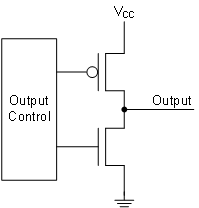SLYS056A August 2024 – September 2024 TMAG5233
PRODUCTION DATA
- 1
- 1 Features
- 2 Applications
- 3 Description
- 4 Device Comparison
- 5 Pin Configuration and Functions
- 6 Specifications
- 7 Detailed Description
- 8 Application and Implementation
- 9 Device and Documentation Support
- 10Revision History
- 11Mechanical, Packaging, and Orderable Information
Package Options
Mechanical Data (Package|Pins)
- DBV|3
Thermal pad, mechanical data (Package|Pins)
Orderable Information
7.3.2 Output Type
The TMAG5233 is an omnipolar switch, meaning the OUT pin responds to both positive and negative magnetic flux densities. As an active low, push-pull (CMOS) output device, the TMAG5233 pulls the output low when the magnetic flux density exceeds the magnetic operate point (BOP). The output remains low until the magnetic flux density falls below the magnetic release point (BRP). Figure 7-6 shows this omnipolar, active low output behavior. Figure 7-7 shows a simplified diagram of the push-pull CMOS architecture that allows the device to drive the output high or pull the output low, eliminating the need for an external pullup resistor.
 Figure 7-6 Omnipolar Output Response
Figure 7-6 Omnipolar Output Response Figure 7-7 Push-Pull (CMOS) Output
(Simplified)
Figure 7-7 Push-Pull (CMOS) Output
(Simplified)